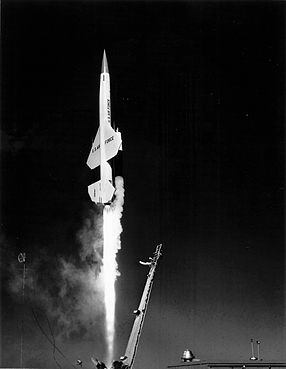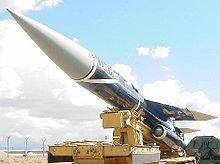Bomarc
| Bomarc | |
|---|---|
| General Information | |
| Type | Anti-aircraft missile |
| Local name | XF-99, XM-99A |
| NATO designation | CIM-10 Bomarc |
| Country of origin |
|
| Manufacturer | Boeing |
| development | 1949 |
| Commissioning | 1959 |
| Working time | 1961-1972 |
| Technical specifications | |
| length |
CIM-10A : 14.20 m, CIM-10B : 13.70 m |
| diameter | 890 mm |
| Combat weight |
CIM-10A : 7,020 kg CIM-10B : 7,250 kg |
| span | 5,540 mm |
| Drive First stage Second stage |
CIM-10A : Liquid fuel booster Aerojet General LR59-AJ-13 CIM-10B : Solid fuel booster Thiokol M51 CIM-10A : 2 × Ramjet Marquardt RJ43-MA-3 CIM-10B : 2 × Ramjet Marquardt RJ43-MA-7 |
| speed |
CIM-10A : Mach 2.8 CIM-10B : Mach 3.0 |
| Range |
CIM-10A : 400 km CIM-10B : 710 km |
| Service ceiling |
CIM-10A : 20,000 m CIM-10B : 30,000 m |
| Furnishing | |
| steering | Inertial navigation system , data link |
| Target location | Active radar target search |
| Warhead | W40 7-10 kt nuclear warhead or fragmentation warhead |
| Detonator | Radar proximity detonator |
| Weapon platforms | Stationary position |
| Lists on the subject | |
The Bomarc was a remote-controlled anti-aircraft missile of the Cold War era from American production. It could be equipped with a nuclear warhead . With ramjet engines and wings , it achieved a range of 700 kilometers at a speed of up to Mach 2.8.
The name Bomarc is made up of the manufacturers Boeing (BO) and the Michigan Aeronautic Research Center (MARC) = BOMARC. The original designation of the US Air Force - XF-99 - incorporated the Bomarc into the range of fighter aircraft. Shortly after the first flight, the name was first changed to IM-99A , before CIM-10 was finally determined as the final name in 1963 .
development
In the Cold War, the standing United States and the Soviet Union before the development of intercontinental ballistic missiles only as nuclear weapons carriers long-range bombers available. The Bomarc, developed from the early 1950s and put into service from June 1961, was designed to counter this threat. In addition to its original purpose, the Bomarc also served as a target drone for testing other weapon systems.
About 700 missiles were produced. 14 Bomarc positions in the USA and two in Canada were set up to intercept attacks by Soviet bombers over the North Pole .
The program led to fierce political controversy in Canada from 1960, when the nuclear equipment of the missiles had become known. After Pierre Trudeau had already worked as a journalist against the Bomarc, he announced after his election as Prime Minister of Canada in 1968 that he would dismiss the positions in 1971.
From the mid-1960s, the main threat shifted from strategic bombers to ICBMs. In 1972 the last Bomarc unit in the USA was disbanded.
technology

As a ground-based air defense missiles long range the Bomarc had to start a rocket motor and a cruise engines two Marquardt RJ43 - ramjet engines (ramjet). Two variants were developed - Bomarc A and Bomarc B, designated as CIM-10A and CIM-10B from 1963.
The first model - the 'Bomarc IM-99A' (IM for Interceptor Missile ) - flew at Mach 2.8 at a cruising altitude of 18 km. It was 14.2 m long, weighed 7020 kg and had a range of 320 km. A liquid fuel rocket motor was used in the launch stage . The Bomarc B used a solid propulsion system because the liquid fuel had the disadvantage that it could only be refueled immediately before take-off and the fuel was dangerous to handle. The ramjet engines of both variants, however, hardly differed.
The Bomarc were housed in special shelters, from where they could be automatically raised vertically and started.
Target determination and tracking as well as the control of the Bomarc was carried out by SAGE, the Semi-Automatic Ground Environment - a network of radar stations and computer systems that were enormous due to the technology of the time. At a distance of 16 km to the target took on the onboard AN / DPN-34 radar, the control to the interception point where the conventional warhead or a W40 - nuclear warhead with 10 kT TNT equivalent has been ignited.
Web links
Individual evidence
- ^ John M. Andrade: US Military Aircraft Designations and Serials , Midland Counties Publ., P. 106

